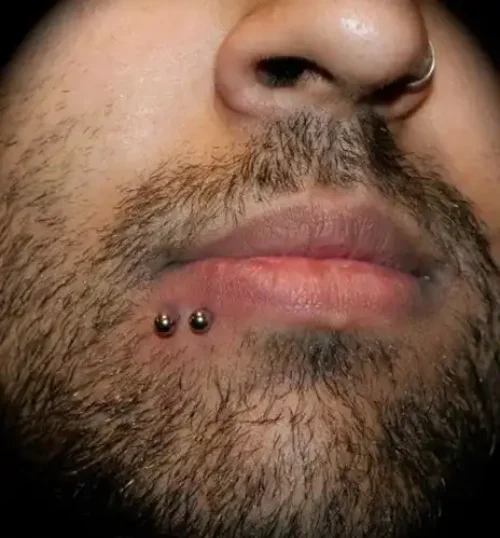Spider Bite Piercing
Key Points About Spider Bites Piercing:
- Placement: The two piercings are done next to each other on the same side of the lower lip.
- Jewelry:
– Small labret studs or captive bead rings are commonly used.
– Start with longer jewelry to allow room for swelling. - Pain Level: Pain varies by individual, but on average, it rates 3–5 out of 10 since the lower lip is soft tissue.
- Healing Time:
– Takes 6 to 8 weeks to heal fully.
– Healing may extend if not cared for properly. - Aftercare Tips:
– Clean the piercings with saline solution twice a day.
– Avoid touching the piercings with dirty hands.
– Refrain from smoking, alcohol, and spicy foods during healing.
– Rinse your mouth with alcohol-free mouthwash after meals. - Risks:
– Swelling, irritation, infection, and possible tooth or gum erosion.
– Regular checkups with your piercer can ensure proper healing. - Style:
– Perfect for edgy, bold looks.
– You can swap out jewelry for hoops or unique studs after healing.
Spider Bites Piercing Procedure
The spider bites piercing procedure is a relatively quick and straightforward process when performed by a professional piercer. Here’s a step-by-step overview of what to expect:
- Consultation and Preparation
– Our piercer will discuss the placement, jewelry options, and aftercare instructions with you.
– You’ll be asked about any allergies (e.g., metals like nickel) or health concerns.
– Our piercer will clean the area around your lower lip with an antibacterial solution to ensure it’s sterile. - Marking the Placement
– Our piercer will mark two small dots on your lower lip using a sterile marker where the piercings will go.
– You’ll check the markings in the mirror to confirm the placement is to your liking. - The Piercing
– You’ll sit or lie down in a comfortable position.
– Ourpiercer will use a sterilized hollow needle to pierce the first marked spot.
→ A clamp may be used to hold the lip steady, though some piercers prefer to work freehand.
– The jewelry (usually a labret stud) is immediately inserted into the hole to keep it open.
– The process is repeated for the second piercing. - Pain Level: Pain is minimal to moderate since the lower lip is soft tissue. Many people describe it as a quick pinch.
- Aftercare and Final Steps
– Once both piercings are done, the piercer will clean the area again to remove any blood.
– You’ll receive aftercare instructions, which include:
→ Rinsing with saline solution or alcohol-free mouthwash.
→ Avoiding smoking, spicy foods, and alcohol during healing.
→ Keeping the area clean and not touching the jewelry with dirty hands.
– Swelling is normal for the first few days. The piercer may use slightly longer jewelry to allow room for swelling. - Healing Process
– Initial healing takes 6 to 8 weeks, though full healing may take longer.
– Regular cleaning is essential to prevent infection or complications.
What to Expect During the Procedure:
- Duration: About 10–15 minutes for marking, piercing, and inserting jewelry.
- Pain: A quick pinch followed by mild discomfort.
Considerations before getting a Spider Bites Piercing
Before getting a Spider Bites Piercing, there are several important considerations to keep in mind to ensure a safe experience and smooth healing process:
- Research a Professional Piercer
– Choose a professional and reputable piercer who follows strict hygiene protocols.
– Ensure they use sterilized, single-use needles and high-quality jewelry.
– Check reviews or portfolios of their work to assess their experience. - Pain Tolerance
– The pain level is generally 3–5 out of 10, but this can vary based on individual pain thresholds.
– Consider whether you are comfortable with the process, as you’ll be getting two piercings on the same day. - Oral Health and Lifestyle
– Healthy gums and teeth are essential. Poor oral hygiene can lead to complications like infections or gum recession.
– If you smoke, vape, or drink alcohol frequently, healing may be slower. Be prepared to minimize these habits. - Healing Time Commitment
– Healing takes 6–8 weeks for initial recovery, but full healing may take longer.
– During this time, you’ll need to:
→ Avoid spicy, acidic, or hard foods that can irritate the piercing.
→ Commit to regular cleaning with saline solution and alcohol-free mouthwash. - Jewelry Selection
– Start with high-quality jewelry like titanium, surgical steel, or gold to avoid allergic reactions.
– Our piercer will likely use longer labret studs initially to accommodate swelling.
– Be prepared to downsize the jewelry after swelling subsides to prevent gum or tooth damage. - Potential Risks and Complications
– Swelling and irritation are common in the first few days.
– Risk of infection if aftercare isn’t followed properly.
– Prolonged contact with jewelry may cause:
→ Gum recession
→ Tooth erosion (especially if you bite or play with the jewelry)
– Scarring or asymmetry can occur if the piercings are not done properly. - Facial Aesthetics and Lifestyle
– Consider how the piercing aligns with your personal style, work dress code, or social settings.
– If you engage in sports or activities that involve facial contact, piercings may pose a risk. - Financial Commitment
– Factor in the cost of the piercing, high-quality jewelry, and any aftercare products.
– Budget for jewelry changes after healing. - Allergies or Health Concerns
– Inform your piercer of any metal allergies or skin sensitivities.
– If you have conditions like diabetes or a weakened immune system, healing may take longer. Consult with your doctor first. - Aftercare Responsibility
– You’ll need to commit to consistent oral and piercing care:
→ Clean with saline solution twice daily.
→ Avoid touching or playing with the jewelry.
→ Rinse your mouth after meals with alcohol-free mouthwash.
Pain and Healing for a Spider Bites Piercing
Pain Level
The spider bites piercing involves two piercings on the same side of the lower lip, so pain will be slightly higher compared to a single lip piercing.
- Pain Rating: 3–5 out of 10
- Most people describe the sensation as a quick pinch or sharp pressure that subsides quickly.
- Pain tolerance varies by individual, but the lower lip is soft tissue, making it less painful than cartilage piercings.
Factors Influencing Pain:
- Individual pain threshold
- The skill and experience of the piercer
- Your stress or anxiety level during the procedure
Tip: Relax, breathe steadily, and trust your piercer. This can make the experience much smoother.
Healing Process
Spider bites piercings typically heal in two stages: initial healing and full healing.
- Initial Healing Time:
– 6 to 8 weeks for the swelling and tenderness to reduce significantly.
– During this period, the body forms a protective layer around the piercing. - Full Healing Time: Can take 3–6 months for the tissue to completely heal, depending on aftercare and lifestyle.
What to Expect During Healing
- Swelling:
– Swelling is normal for the first 3–5 days.
– Our piercer will use slightly longer jewelry to allow for this. - Discomfort: Tenderness, slight bruising, and redness around the piercing are normal initially.
- Discharge: A small amount of clear or whitish fluid (lymph) may form around the piercing. This is part of the healing process.
Signs of Healing vs. Infection
- Normal Healing Signs:
– Swelling decreases after a few days.
– Minor redness and clear discharge. - Infection Signs (seek medical advice):
– Persistent swelling, redness, or heat.
– Yellow or green discharge with a foul smell.
– Severe pain or fever.
Managing Pain and Swelling
- Use a cold compress or suck on ice chips to reduce swelling.
- Take over-the-counter painkillers like ibuprofen (if safe for you) to manage discomfort.
- Avoid sleeping on your face to prevent pressure on the piercings.
Spider Bites Piercing Aftercare Guide
Proper aftercare is essential to ensure a smooth healing process and to prevent infections or complications for your spider bites piercing. Here’s a step-by-step guide:
- Clean the Piercings Daily
– Use a sterile saline solution or a sea salt soak twice a day:
→ Mix 1/4 teaspoon of non-iodized sea salt in 8 oz of warm distilled water.
→ Soak a clean cotton ball or pad in the solution and gently clean around the piercings.
– Avoid using alcohol, hydrogen peroxide, or harsh antiseptics as they can irritate and delay healing. - Rinse Your Mouth After Eating and Drinking
– Use an alcohol-free mouthwash or saline rinse after every meal or drink to keep the inside of the piercings clean.
– Stay away from sugary or acidic drinks that can irritate the piercings. - Minimize Swelling
– Suck on ice chips or drink cold water to soothe the area and reduce swelling.
– Avoid sleeping on your face or putting pressure on the piercing.
– Take over-the-counter anti-inflammatory medication like ibuprofen if needed (consult a doctor first). - Avoid Touching or Playing with the Jewelry
– Do not twist, touch, or move the jewelry unnecessarily. This can introduce bacteria or cause trauma to the healing tissue.
– Always wash your hands thoroughly before cleaning the piercing. - Watch Your Diet
– Avoid foods and drinks that can irritate the piercings:
→ Spicy, salty, or acidic foods
→ Hot beverages like coffee or tea
→ Alcohol (including mouthwashes with alcohol)
– Stick to soft foods for the first few days to prevent discomfort. - Say No to Smoking and Kissing
– Smoking and vaping can introduce harmful bacteria and slow down healing. Try to avoid them as much as possible.
– Avoid kissing or oral contact, as this increases the risk of infection. - Keep the Outside of the Piercing Clean
– Gently clean the outer area of the piercing using saline solution and a clean, soft cloth or gauze.
– Pat dry with a clean paper towel (avoid regular towels, which can harbor bacteria). - Avoid Makeup and Skincare Products
– Do not apply lip gloss, lipstick, or other cosmetic products near the piercings during healing.
– Avoid skincare products or lotions that may get into the piercing holes. - Jewelry Care
– Our piercer will start with longer jewelry to accommodate swelling.
– After the initial healing phase, visit your piercer to downsize the jewelry to avoid gum or tooth damage.
– Only use high-quality materials like surgical steel, titanium, or gold to minimize allergic reactions. - Be Alert for Infection
– Signs of a normal healing process include minor redness, swelling, and clear discharge. However, seek medical attention if you notice:
→ Persistent pain, swelling, or heat around the area.
→ Yellow or green discharge with a foul odor.
→ Excessive bleeding or fever.
General Healing Time
- Initial Healing: 6–8 weeks
- Full Healing: Up to 3–6 months
Spider Bites Piercing Jewelry Guide
Choosing the right jewelry for your spider bites piercing is essential for comfort, healing, and style. Here’s a breakdown of the best jewelry options, materials, and considerations:
Types of Jewelry for Spider Bites Piercing
- Labret Studs (Ideal for Initial Healing):
– A straight bar with a flat back and a decorative top (ball, gemstone, or unique designs).
– Flat backs are comfortable and reduce irritation to gums and teeth. - Captive Bead Rings (CBRs):
– Circular rings with a small bead that snaps into place.
– Offers a bold, edgy aesthetic once healing is complete. - Seamless Rings or Hoops:
– Smooth, thin rings that create a sleek and minimal look.
– Best for healed piercings to avoid irritation during the healing process. - Circular Barbells:
– A horseshoe-shaped ring with two beads on each end.
– Great for versatility and style customization.
Jewelry Material Options
For safety and to avoid allergic reactions, opt for high-quality, hypoallergenic materials:
- Titanium (Recommended for Healing):
– Lightweight, hypoallergenic, and corrosion-resistant.
– Ideal for sensitive skin as it contains no nickel. - Surgical Stainless Steel:
– Durable, affordable, and commonly used.
– Avoid if you have nickel allergies, as it contains trace amounts. - 14k or 18k Solid Gold:
– A stylish, hypoallergenic option for healed piercings.
– Avoid plated or low-quality gold, as it can cause irritation. - Niobium:
– Soft, flexible, and hypoallergenic.
– A good alternative to titanium. - Bioplast or PTFE:
– Flexible, lightweight plastic that reduces irritation.
– Great for minimizing contact with gums or teeth.
Sizing Guide
- Gauge Size: Standard size is 16G (1.2mm thickness) for most lip piercings.
- Length:
– For initial healing, jewelry should be slightly longer (e.g., 8mm–10mm) to accommodate swelling.
– Once healed, you can downsize to 6mm–8mm to prevent gum and tooth damage.
Style Options for Jewelry Tops
- Classic Ball Ends: Minimalist and clean look.
- Gemstones: Add sparkle with cubic zirconia or opal tops.
- Flat Discs: Sleek and comfortable, especially for labret studs.
- Unique Shapes: Options like stars, hearts, spikes, or custom designs can showcase your personality.
Changing Jewelry
- Wait until the piercing is fully healed (6–8 weeks or longer) before changing jewelry.
- Visit your piercer for downsizing to prevent irritation or migration.
Jewelry Maintenance
- Clean jewelry regularly with saline solution or mild soap and water.
- Avoid removing jewelry for extended periods to prevent the holes from closing.
Popular Looks for Spider Bites Piercings
- Double Labret Studs for a subtle, sleek appearance.
- Hoops or CBRs for an edgy, bold style.
- Mix-and-Match Designs: Combine a stud and a hoop for a unique asymmetrical look.
Cost of a Spider Bites Piercing in Nairobi, Kenya
The cost of a spider bites piercing can vary depending on location, studio reputation, and jewelry choice. Here’s a detailed breakdown of what to expect:
Average Cost
- General Price Range: Ksh. 3,000 – Ksh. 5,000
– This price typically covers the procedure for both piercings (spider bites include two piercings).
– It may include basic starter jewelry (usually stainless steel or titanium).
Factors That Influence Cost
- Studio Reputation and Location:
– High-end, professional studios in cities or upscale areas charge more. Rebel Inks Tattoos, Tattoo Removal, and Body Piercings Parlour is located in the heart of the Central Business Disrict (CBD) in Nairobi, Kenya, and is easily accessible to both locals and foreigners in the country.
– A more experienced piercer may charge higher fees due to their expertise. At Rebel Inks Tattoos, Tattoo Removal, and Body Piercings Parlour we have experienced professionals who offer quality and premium services. - Jewelry Choice:
– Basic jewelry like surgical steel is included in many prices.
– Upgrading to titanium, gold, or custom jewelry can increase the cost by Ksh. 500 – Ksh. 2,000
– Jewelry with gemstones or unique designs may cost even more. - Piercer’s Experience: Highly experienced, licensed piercers charge more for their skills, but they also reduce the risk of complications.
- Aftercare Products:
– Saline solution or sea salt soaks are often recommended and may cost an additional Ksh. 500 – Ksh. 1,000
– Some studios provide aftercare kits as part of the total price.
Spider Bites Piercing Cost Breakdown Table
Component / Package | Estimated Cost (KSh) | Details / Notes |
Piercing procedure for both holes (Spider Bites) | 3,000 ‒ 5,000 | Basic procedure + starter jewelry (steel or titanium) |
Upgraded jewelry (per piece) | 500 ‒ 2,000 | Gold, decorative ends, gems, or hypoallergenic materials |
Aftercare kit / cleaning supplies | 500 ‒ 1,000 | Saline spray, cleaning solution, instructions |
Follow-up / check-up | 200 ‒ 500 | For downsizing jewelry after healing or checking placement |
Total – Budget/Standard Package | 3,500 – 6,000 | Procedure + basic jewelry + minimal aftercare |
Total – Premium Package | 6,000 – 8,500 | Includes upgraded jewelry, perhaps gem ends, decorative style, better aftercare |
Why You Shouldn’t Choose “Cheap” Piercing Services
Opting for a lower price may compromise:
- Hygiene Standards: Cheaper studios may cut corners on sterilization.
- Jewelry Quality: Poor-quality jewelry can cause infections or allergic reactions.
- Skill Level: Inexperienced piercers increase the risk of incorrect placement, scarring, or complications.
Invest in quality for safety and comfort!
Possible Side Effects of Spider Bites Piercing
While a spider bites piercing is generally safe when done professionally, there are potential side effects and risks to consider during and after the healing process. Here’s what you need to know:
- Swelling and Bruising
– What Happens: The lower lip area often swells for the first few days due to the trauma of the piercing.
– How to Manage:
→ Use cold compresses or suck on ice chips.
→ Avoid spicy or salty foods that can aggravate swelling. - Infection
– Signs of Infection:
→ Persistent redness, swelling, or heat around the piercings.
→ Yellow or green discharge with a foul smell.
→ Increased pain or fever.
– How to Prevent It:
→ Clean the piercings with saline solution twice daily.
→ Rinse your mouth after meals with alcohol-free mouthwash.
→ Avoid touching the jewelry with unwashed hands. - Gum Recession
– What Happens: Jewelry (especially if too large or improperly sized) can rub against the gums, causing them to recede over time.
– Prevention:
→ Opt for smaller, well-fitted jewelry after the initial healing period.
→ Avoid playing with or biting down on the jewelry. - Tooth Damage
– What Happens: Jewelry can chip or erode teeth if it hits them frequently during talking or chewing.
– How to Prevent It:
→ Switch to flat-back labret studs instead of hoops during healing.
→ Be mindful of your movements to avoid biting down on the jewelry. - Scarring or Keloids
– What Happens: Improper healing, trauma, or irritation can lead to hypertrophic scarring or keloids (raised scar tissue).
– How to Minimize It:
→ Avoid touching or irritating the piercings.
→ Follow aftercare instructions consistently.
→ Consult a piercer if a bump forms—they can recommend treatments like saline soaks. - Jewelry Rejection or Migration
– What Happens: The body may push the jewelry out (rejection) or the piercing may shift position (migration).
– Causes: Poor jewelry quality, improper placement, or trauma.
– Prevention:
→ Use hypoallergenic jewelry (e.g., titanium or gold).
→ Avoid physical trauma or tugging on the jewelry. - Allergic Reactions
– What Happens: Sensitivity to jewelry materials (like nickel) can cause itching, redness, or rash-like symptoms.
– Prevention:
→ Start with high-quality materials like titanium, niobium, or solid gold.
→ Avoid cheap or plated jewelry. - Excessive Saliva Production
– What Happens: Your body may react to the new jewelry by producing more saliva. This usually resolves after a few days. - Difficulty Eating or Speaking
– What Happens: Swelling and the presence of jewelry can make it hard to eat, drink, or pronounce certain words initially.
– How to Manage:
→ Stick to soft foods and drink plenty of water during the first few days.
→ Practice speaking slowly as you adjust to the jewelry. - Piercing Bumps
– What Happens: Small red or clear bumps may develop due to irritation or improper aftercare.
– How to Manage:
→ Use saline soaks to reduce irritation.
→ Avoid touching or picking at the bump.
How to Avoid Most Side Effects
- Choose a Professional Piercer: Ensure they use sterile equipment, and have experience with lip piercings.
- Follow Aftercare Guidelines: Clean twice daily, avoid irritants, and don’t play with the jewelry.
- Use High-Quality Jewelry: Start with titanium, surgical steel, or gold to minimize reactions.
- Avoid Oral Contact: Don’t kiss, smoke, or consume alcohol during the healing process.
Related Piercing
Get In Touch
For more information on the list above and any other special services,please call or come in for free consultation
Testimonials
I recommend them 💯
I would definitely recommend if you’re thinking of getting a piercing!
The staff were super friendly, explained everything clearly, and made me feel so at ease. They answered all my nervous questions (and I had many questions),
They walked me through the whole process, gave detailed aftercare instructions, and even followed up afterward to check how I was healing 🫶
Clean, professional, and full of good vibes.
Would 100% recommend . Definitely making a second trip here.
This was the second tattoo I got and I wish I could have come to Eric for my first one! He gave me really great after-care directions for the tattoo as well as a little jar of his own Vaseline-type stuff to put over my tattoo while it was healing! He even put second skin over my tattoo so that I didn’t have to worry about it for the first few days. Now THAT’S good service. My first tattoo artist didn’t do none of that lol.
After the session Eric didn’t rush me and my friend out, he chatted with us and even when he found out I was an artist too— really encouraged me to keep creating and to find a community of artists to support me. I almost cried because I’ve had such a hard time with my own art the past couple of years, it meant so much to me to have a fellow very talented artist say that to me. 🤍🤍🤍
Eric you’re amazing, don’t ever stop creating and just know you’ve impacted lives all over the world!🫶🏻 thanks so much for everything!!
From the moment I walked in, Eric was professional, welcoming, and attentive. He made sure I was comfortable throughout, provided everything I needed, and explained every step of the process. The tattooing itself was unbelievably smooth - I genuinely felt no pain compared to my previous tattoos over the last 22 years.
Eric also gave me excellent aftercare guidance and products, and thanks to that, my tattoo healed beautifully. The attention to detail, precision, and shading are absolutely stunning. This is hands-down the best tattoo I've ever had, and I will be flying back to Nairobi for any future ink.
If you want incredible art, a professional experience, and a talented artist who truly cares about his clients, Rebel Ink is the place to go!
From start to finish, the service was exceptional. The piercer was professional, knowledgeable, and made me feel completely comfortable. The cleanliness of the place was above and beyond — everything was spotless and hygienic, which really put me at ease. Highly recommend for anyone considering a piercing!
Shout out to Eric😘
We ended up changing the jewelry three times to ensure I had the best fit and avoided any signs of rejection, and he always listened to my suggestions as a client, which I really appreciated. Now, three months in, my piercing is healing beautifully, with no sign of rejection. Highly recommend for anyone who values a piercer who cares about your comfort and healing journey!
What stood out the most was the aftercare Eric checked in with me even three weeks later to see how the tattoo was healing. That kind of follow-up shows how much he truly cares about his work and his clients.
I’m very satisfied and will definitely be coming back for my next piece. Highly recommend!
The piercing wasn't as painful as I had thought and the process was quick and satisfactory. I love it!!!
The piercing is healing well thanks to the aftercare instructions and follow-up. I would highly recommend Rebel Inks
Eric also did a belly button piercing for a friend, guiding her through the process, doing the piercing and then explaining the after care to her.
The shop is on the 3rd floor, with the entrance to the stairs near an alleyway on the left. The shop is perfect size, clean, and attractive looking. The mural is pretty dope.
Thank you for the amazing service! 🔥👅✨
I got piercibgs there and the process was really good. My biggest concern was hygiene but that wasn't an issue at all, they use new needles and they sanitize them.
The service itself was also welcoming.
I was informes of everything i needed to know beforehand.
10/10 would recommend!
Eric was so calm and patient with my almost 2 year old lady. It was such a clean and hygienic process. We will definitely be back for our second rounds of piercings and maybe even another tattoo!
They assess the area before any art and advise one accordingly. They also give one post clean up process and also do a check up after the body art projects. Overall, I loved my experience and I’m hooked. 👍
Will definitely come back next time I’m in town 🙂
He listened to what I actually wanted and made sure he could fit in the time before I flew back home.
The shop is clean & private and is easy enough to find.
Eric has even checked in a couple of times since to make sure all is good.
I would totally recommend Eric! I absolutely love my Elephants!
I had a very easy healing period and always follow up from Eric to check on my progress...I would highly recommend if you are a first timer because from my experience all went very well and attention to detail
Thank you for a good job and looking forward to send all my friends your way
And all the best with the new year 2025!
From the moment I walked in, the staff was super friendly and made me feel at ease. The studio had a clean, professional atmosphere, which immediately put me at ease. My piercer was incredibly skilled and explained every step of the process, ensuring I was comfortable the entire time. The piercing was quick and practically painless, and the aftercare instructions were clear and easy to follow. I can tell they really care about the health and safety of their clients.
Overall, a fantastic experience—I highly recommend Rebel Inks and Tattoos for anyone looking to get pierced or tattooed!
They do follow up after their services
Eric's Studio isn’t just a place to get a tattoo—it’s an experience. The combination of professionalism, artistic talent, and a welcoming environment makes it a standout destination for anyone considering a tattoo.
I highly recommend Eric’s Studio to both first-timers and seasoned tattoo enthusiasts. If you’re looking for a high-quality tattoo and an enjoyable experience, this is the place to go.
I would definitely recommend their services again and again
Thank you Rebel Ink
My piercings are healing ❤️🩹 well
I would 💯 recommend
I will definitely come back for more .
Two, all the equipments he used for the piercings were new and/or sterilised.
Three, the parlour itself was very clean and was up to par with the hygiene standards.
Four, Eric provided effective aftercare instructions, making sure I knew exactly how to take care of my new piercings and he kept in touch and continues to do so, to check on the healing progress.
I highly highly highly recommend this place!!!
Would definitely recommend them to friends and go back for other piercings
Not only was the piercing process smooth, but he also provided thorough aftercare instructions, making sure I knew exactly how to take care of my new piercings. What really impressed me was that he keeps in touch to check on how the healing is progressing – a sign of true care for his clients.
The shop maintains a high standard of hygiene, and the atmosphere is welcoming and comfortable, which really added to the positive experience. I highly recommend this place to anyone looking for a professional and caring experience. I’ll definitely be coming back for any future piercings!
My appreciation for the excellent customer service I received. The follow-ups were prompt, and I truly appreciated the gentleness and professionalism throughout. Thank you!"
"Looking for professional eyebrow microshading removal? Look no further!"
The customer care is top tier 👌🏾👌🏾.
Wonderful place to get tattoos and piercings. 💯💯
Eric goes ahead to follow up on his clients progress and gives good advice each time I reach out to him.
I would recommend Reble tattoos anytime.
Good job bro we really appreciate.
Ohh and the price is very fair.
The environment was clean , procedure was sterile and the jewelry used are of the best quality.
He followed up with me during the healing process, he educated me on what I needed to do for my aftercare.
Eric is confident, skilled , experienced and the best piercer. Highly recommend Rebel inks.✨
Definitely recommend!
Great experience.
Eric definitely know what he is doing .
I got exactly what I wanted 2 tiny tats on the same finger .
He was kind and patient throughout the session.
Healing process has been good .
Aftercare services were given and regular checkups on the healing process were done.
I would 💯recommend.
Eric gave me the best reception as it was my first time there,and made me trust him all the way. I appreciate good services.
There services are also affordable not to forget 😊.
He was also invested in the aftercare and would ensure I follow the do's and don'ts in taking care of the tattoo and ensuring proper healing and maximum ink retention.
Would highly recommend Rebel Inks Tattoos.
Rebel Inks Tattoo offer the best,affordable and quality tattoo removal services.If you have unwanted ink,choose Rebel Inks Tattoo,they're the best of the best and the professionalism is a top notch.They ensure you're free from unwanted ink with their Laser Tattoo Removal Technology...
I did a Laser Tattoo Removal with them and i can attest they're the best....
Kudos Eric...
I highly recommend.
It was a generally good experience with good hygiene during the piercing process and has been a smooth healing process.... 10/10
tips. Highly recommend 👍🏽
100% recommendable.
I was particularly impressed with Eric's attention to hygiene. He thoroughly cleaned the room before I entered, sanitized all of the equipment he would be using, and changed gloves between each ear. This level of cleanliness gave me great confidence in his professionalism.
Eric's commitment to customer service did not end on the day of the piercing. He followed up with me regularly throughout the healing process to ensure that I was following the aftercare instructions and that my earlobes were healing properly.
I highly recommend Rebel Inks to anyone in Nairobi who is considering getting a piercing. Eric is a highly skilled and experienced piercer who takes great pride in his work.
So I Check all the boxes below and more:
Customer Care: ✔️
Professionalism : ✔️
Cleanliness ✔️
Price: ✔️
After care service ✔️
Thanks and good job, Eric
The place is neat and clean and the equipments he used were also fine standards. Really appreciate his following up with me on the healing 🤗
I WOULD HIGHLY RECOMMEND THEIR SERVICES to everyone. Actually what you see on their website is EXACTLY what you will get. Keep up the good work Rebel inks Tattoos.
The infection is now gone. I would definitely recommend!
Can recommend this place totally and would go back there anytime!
Thanks!
OUR LOCATION
Areas We Serve
NAIROBI
KIAMBU
KAJIADO
MACHAKOS


































































































































































































































